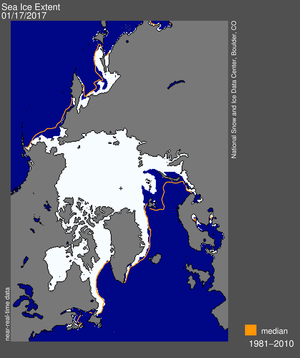Barrow, Alaska
January 16, 2014
-32°C (-26°F), clear, light wind
Sometimes it seems like 90% of my job is waiting for ice to melt. And the other 10% is me taking selfies of my epic beard-cicles.
We measured the temperature of this ice every 10 cm (4 in) in the field and then cut it up into pieces. We’ll measure the salinity of the melted water in each of those pieces, and then we’ll be able to calculate the amount of liquid water in the ice.
This is important because all of the life within the ice actually lives inside pockets of water kept liquid because of the salt. At lower temperature the pockets are smaller and fewer organisms can live inside. The pockets are also saltier at low temperature, which most organisms don’t like, so they’re found more often down at the bottom of the ice near where it touches the “warm” seawater.
Yesterday we collected sea ice and at first glance there didn’t seem to be much in there. The bottom of the ice, where it contacts the seawater, is colored a rich brownish-green by algae during the spring and summer, but in the winter, with such little light, they are not able to grow. So the ice is very clear, and we really weren’t expecting to see much in the way of algae. We did find some cool stuff, though.
Copepods — these are quite possibly the most abundant animals on Earth, and are found almost anywhere that there is water, including the brine channels in sea ice! There are predatory copepods, vegetarian copepods, and parasitic copepods.
The most abundant animals we’ve been finding in the sea ice are turbellarians, which are platyhelminthe flat worms.
Here’s a (staged) video of a sea ice turbellarian swimming around in the ice.
And a close-up of a different species — this one has striking eye spots that are made up of a cluster of light-sensitive receptors.
While we were out, we also collected some sediment from each site. Comparing the sediment from the different sites is interesting because the geologic and oceanographic conditions determine what kind of sediment is found at a site.
The sediment on the left is from the Mass Balance Site and consists almost entirely of very small grains, <500 micrometers (smaller than the dot at the end of this sentence.) The sediment on the right is from the NARL site, closer to base camp. It has a much larger distribution of grain sizes including much larger pebbles.
One difference between these locations is that the Mass Balance site is in a slight embayment and is protected from the stronger currents along the coast, so smaller grains can settle out of the water column. The NARL site has slightly faster currents and the smallest grains are swept along to be deposited elsewhere, leaving more of the larger grains.
We didn’t find very many animals at either site. At the Mass Balance site there were a few tiny bivalves (clams) and polychaete worms. By far the most common critters were nematode worms.
And that’s just a sampling of what is known and what remains to be discovered out there!
Have any questions? Want to tell us your favorite Arctic animal? Leave it in the comments or on Twitter @cryomics
Tags: alaska · arctic · barrow · biology · field work · microbes · sea iceNo Comments



0 responses so far ↓
There are no comments yet...add one by filling out the form below.